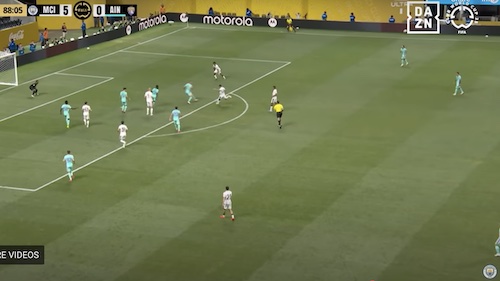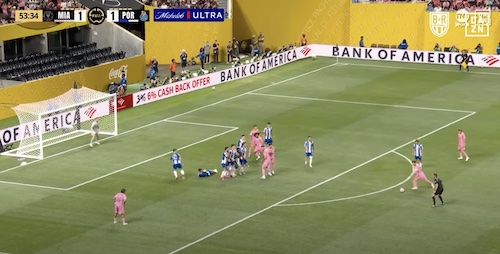Boxes is a soccer drill straight from Manchester United’s daily training sessions. It’s nothing complex or mysterious. There’s no secrets or tricks. Rather it’s a simple soccer drill that Manchester United and most teams around the world do everyday, it’s called keep away, rondos or piggy in the middle. Really, it’s just keep away in a tight space or box.
“I love going out and doing boxes – it’s the best part about training,” says Rio Ferdinand. “I think 90% of the lads would agree. If Carlos Queiroz changes the training session around and tells us we’re not doing boxes, I go bananas. I need to do a box to start the day off on a good vibe.
“Paul Scholes is probably the best at boxes. His awareness and touch is always spot-on. I was shocking in my first season at the club. I felt more pressure in that box than I did walking out at Old Trafford. After the first year I got used to it and I’d say I’m all right at it now.”
Manchester United’s boxes or keep away is a drill that nearly every team in the world does prior to training but Manchester United, and most pro teams, put a little twist on the drill, as they separate into two groups, the starters or senior players versus the new and younger players.
The boxes soccer drill looks very much like this, but not done in as casual a way as it’s done here in a pre-game warmup. During training or practice the boxes drill might be a bit more serious and with less players and at a higher intensity. Here’s a good look at the Manchester United possession game during warm ups – the boxes soccer drill.
What this does in training is ups the ante just a little bit, makes the simple keep away game more intense. Of course this is a fun drill, but it’s also the foundation of soccer, keeping possession of the ball and away from the opposing team and moving the ball quickly. So why not force players to play at a higher level so they get better. The idea is to get players to strive to want to play with the older and more experienced players – to move up into the senior group.
But how do you play “boxes”? It’s easy. Split up into the two groups, the current starting team and then the younger team, say eight to ten players in each group. In each group two players start out playing defense, trying to win the ball from the six or eight players who are trying to keep the ball in the small area or the box.
The box could be ten yards wide by twenty yards long or even smaller, just make adjustments according to your teams age and playing ability. The smaller the box the faster the players will have to think and the faster the ball will need to move from one player to the next.
The offensive players surrounding the two defenders play with just one touch and if the defender gets a touch on the ball then the player who made the mistake goes into the middle. If a player gets nutmeged, then that player stays in the middle for another round.
To make this “boxes” game even more interesting though, that’s when you move players up into the older group. After say ten minutes, rotate one or two players from the senior group down to the younger group, and rotate one or two younger players up into the senior group.
Rotate the player who has been in the middle the longest in the senior group down to the younger group and then the player who hasn’t been in the middle up to the senior group. Or, you could start out by adding one young player who recently had a good game up with the senior group at the beginning of soccer training when you do the drill. Or, everyday give one younger player a chance to start out playing with the senior group. The idea is to create more intensity in the drill and to build up a sort an incentive and reward system for young players.
And while this is a fun drill to do prior to really getting into a full training session defensive players should go all out. Which they will since they don’t want to stay in the middle too long.
Watch the Seattle Sounders of the MLS play a variation of this keep away drill in the video below. See how small the playing area is. This forces players to react quickly, know what they want to do with the ball before they get it, and get their body/hips open to the playing area.
The boxes drill doesn’t just have to be two groups either, if you have more players you can make it three different groups, but the idea is to put the best players together and setup a sort of hierarchy in the game. And there might be a few days were you put the forwards, midfielders, and defenders into groups so they learn to work together.
In some ways you don’t want to make players afraid of playing with the older players, yet in other ways you do want them to be afraid. If they can learn to play with the best players on the team then they can break into the starting lineup. If they can’t, then they will continue to spend time on the bench. In time players will get more and more comfortable with the drill and slowly but surely they’ll be eager to play with the top or older more experienced players.
From the Guardian: The football squad is split into a junior and senior group and then two members of each group are enclosed by the rest, rather predictably in a box shape. The duo’s aim is to win the ball, while the remainder must keep it from them with one-touch passing.
“Scholesy and Giggsy are probably the best at boxes,” adds Darren Fletcher.
“They’ve been at the club for such a long time, so they’ve got the experience of doing it every day for years – they know the ins and outs of it. When you go into their box, which is the older box, it really is a step up and the play is a lot quicker. It’s a good exercise, there is a lot of mickey-taking mainly because all the lads will try and nutmeg each other. We get some great little passing routines going and we’ve got up to around 30 passes in the past.”















